Exercises for Shoulder Abduction and Adduction
Medically reviewed by Drugs.com. Last updated on Apr 6, 2025.
What are shoulder abduction and adduction exercises?
Shoulder abduction and adduction exercises work the muscles at the back of your shoulder and your upper back.
What should I do before I exercise?
Warm up and stretch before you exercise. Walk or ride a stationary bike for 5 to 10 minutes to help you warm up. Stretching helps increase range of motion. It may also decrease muscle soreness and help prevent another injury. Your healthcare provider or physical therapist will tell you which of the following stretches to do:
- Crossover arm stretch: Relax your shoulders. Hold your upper arm with the opposite hand. Pull your arm across your chest until you feel a stretch. Hold the stretch for 30 seconds. Return to the starting position.
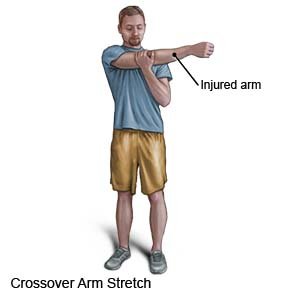
- Shoulder flexion stretch: Stand facing a wall. Slowly walk your fingers up the wall until you feel a stretch. Hold the stretch for 30 seconds. Return to the starting position.
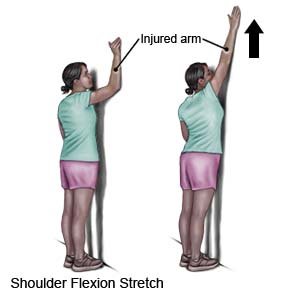
- Sleeper stretch: Lie on your injured side on a firm, flat surface. Bend the elbow of your injured arm 90° with your hand facing up. Use your arm that is not injured to slowly push your injured arm down. Stop when you feel a stretch at the back of your injured shoulder. Hold the stretch for 30 seconds. Slowly return to the starting position.
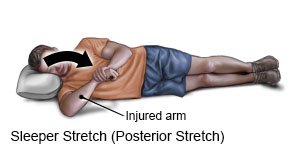
How do I exercise with a weight?
Your healthcare provider or physical therapist will tell you how much weight to use.
- Shoulder abduction: Stand and hold a weight in your hand with your palm facing your body. Slowly raise your arm to the side with your thumb pointing up. Then raise your arm over your head as far as you can without pain. Hold this position for as long as directed. Do not raise your arm over your head unless your healthcare provider or physical therapist says it is okay.
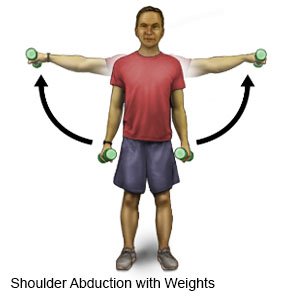
- Shoulder adduction: Lie on your back on a firm surface. Extend your arm out to a "T." Bend your elbow so your forearm in the air. Hold a weight in your hand. Slowly raise your arm toward the ceiling and straighten your elbow. Hold this position for as long as directed. Slowly return to the starting position.
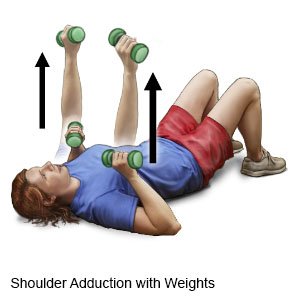
How do I exercise with an exercise band?
Your healthcare provider or physical therapist will tell you how much resistance to use.
- Shoulder abduction: Wrap the exercise band around a heavy, stable object near your foot. Grab the band with the hand of your injured shoulder. Keep your arm straight. Slowly raise your arm to the side with your thumb pointing up. Then, slowly pull the band over your head as far as you can without pain. Do not raise your arm over your head unless your healthcare provider or physical therapist says it is okay. Do not let your shoulder shrug. Hold this position for as long as directed. Slowly return to the starting position.
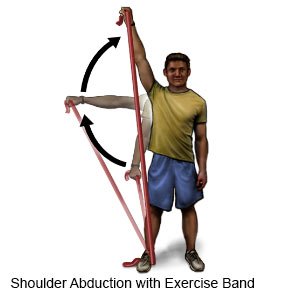
- Shoulder adduction: Wrap the exercise band around a heavy, stable object. Stand and face away from where the band is anchored. Hold each end of the band in both hands with your elbows bent. Your elbows should not be behind your body. Keep your arms parallel to the floor and slowly straighten your elbows. Hold this position for as long as directed. Slowly return to the starting position.
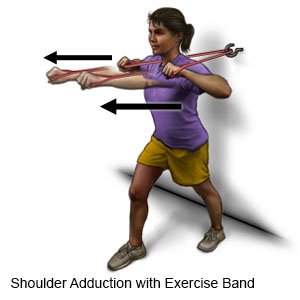
When should I call my doctor or physical therapist?
- You have sharp or worsening pain during exercise or at rest.
- You have questions or concerns about your shoulder exercises.
Care Agreement
You have the right to help plan your care. Learn about your health condition and how it may be treated. Discuss treatment options with your healthcare providers to decide what care you want to receive. You always have the right to refuse treatment. The above information is an educational aid only. It is not intended as medical advice for individual conditions or treatments. Talk to your doctor, nurse or pharmacist before following any medical regimen to see if it is safe and effective for you.© Copyright Merative 2025 Information is for End User's use only and may not be sold, redistributed or otherwise used for commercial purposes.
Learn more about Exercises for Shoulder Abduction and Adduction
Care guides
Further information
Always consult your healthcare provider to ensure the information displayed on this page applies to your personal circumstances.
